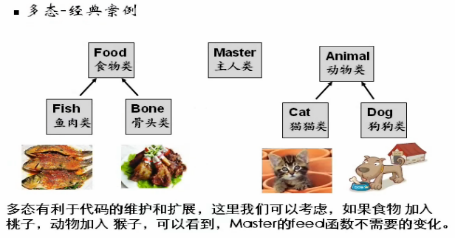JS面向(基于)对象编程--三大特征
抽象
在讲解面向对象编程的三大特征前,我们先了解什么叫抽象,在定义一个类时候,实际上就是把一类事物的共有的属性和行为提取出来,形成一个物理模型(模板)。这种研究问题的方法称为抽象。
封装
什么是封装?
封装就是把抽象出来的属性和对属性的操作封装在一起,属性被保护在内部,程序的其它部分只有通过授权的操作(函数),才能对属性进行操作。
封装--访问控制修饰符
电视机的开关,对音量,颜色,频道的控制是公开的,谁都可以操作,但是对机箱后盖,主机板的操作却不是公开的,一般由专业维修人员来玩。那么在js中如何实现这种类似的控制呢?请看下例:
<!DOCTYPE html>
<html>
<head>
<meta charset="UTF-8">
<title>Document</title>
<script type="text/javascript">
function Person(name, agei, sal) {
this.name = name;//公开属性
var age = agei;//私有属性
var salary = sal;//私有属性
//在类中如何定义公开方法(特权方法),私有方法(内部方法)
//如果我们希望操作私有的属性,则可用公开方法实现
this.show = function() {
window.alert(age+" "+salary);
}
//私有方法,可以访问对象的属性
function show2() {
window.alert(age+" "+salary);
}
}
var p1 = new Person("sp", 20, 50000);
window.alert(p1.name);
p1.show();
p1.show2();//Uncaught TypeError: p1.show2 is not a function
</script>
</head>
<body>
</body>
</html>
js提供有以下几种控制方法和属性的访问权限:
- 公开级别:对外公开
- 私有级别:类本身可以访问,不对外公开
通过prototype给所有对象添加方法,但是这种方法不能访问私有变量和私有方法。
例,
<!DOCTYPE html>
<html>
<head>
<meta charset="UTF-8">
<title>Document</title>
<script type="text/javascript">
function Person() {
this.name = "abc";
var age = 90;
this.abc = function() {
window.alert("abc()");
}
function abc2() {
window.alert("abc2()");
}
}
Person.prototype.fun1 = function() {
window.alert(this.name);// ok
//window.alert(age);// no ok Uncaught ReferenceError: age is not defined
//window.alert(this.age);// 输出undefined
this.abc();// 注意:不要漏掉this
//abc2();// no ok
}
var p1 = new Person();
p1.fun1();
fun1();// Uncaught ReferenceError: fun1 is not defined
</script>
</head>
<body>
</body>
</html>
特别注意:类名.prototype.函数名=function(){}这个也称为后置绑定。
继承
1、为什么需要继承?
<!DOCTYPE html>
<html>
<head>
<meta charset="UTF-8">
<title>Document</title>
<script type="text/javascript">
function MidStu(name, age) {
this.name = name;
this.age = age;
this.show = function() {
window.alert(this.name+" "+this.age);
}
//计算学费
this.payFee = function(money) {
window.alert("应交"+money*0.8);
}
}
function Pupil(name, age) {
this.name = name;
this.age = age;
this.show = function() {
window.alert(this.name+" "+this.age);
}
//计算学费
this.payFee = function(money) {
window.alert("应交"+money*0.5);
}
}
</script>
</head>
<body>
</body>
</html>
问题:以上示例代码冗余。
解决方案:抽象出一个学生类,即把中学生和小学生的共性取出。如下例:
<!DOCTYPE html>
<html>
<head>
<meta charset="UTF-8">
<title>Document</title>
<script type="text/javascript">
//怎么解决代码冗余-->继承
//抽象出一个学生类,即把中学生和小学生的共性取出
function Stu(name, age) {
this.name = name;
this.age = age;
this.show = function() {
window.alert(this.name+" "+this.age);
}
}
function MidStu(name, age) {
/*
window.alert(Stu);
this.stu = Stu;这一句其实相当于下面这句
this.stu = function Stu(name, age) {
this.name = name;
this.age = age;
this.show = function() {
window.alert(this.name+" "+this.age);
}
};
*/
this.stu = Stu;
this.stu(name, age);//JS中实际上是通过对象冒充,来实现继承,这句话不能少,因为js是动态语言(执行的时候才分配空间),如果不执行它则不能实现继承
//MidStu可以覆盖Stu父类的show
/*
this.show = function() {
window.alert("MidStu show();");
}
*/
}
function Pupil(name, age) {
this.stu = Stu;
this.stu(name, age);
}
var midStu = new MidStu("阿昀", 20);
//window.alert(midStu.name);// undefined
//midStu.show();//Uncaught TypeError: midStu.show is not a function
midStu.show();
</script>
</head>
<body>
</body>
</html>
继承--解决之道:
继承可以解决代码利用,让我们的编程更加靠近人类思维,当多个类存在相同的属性(变量)和方法时,可以从这些类中抽象出父类(比如刚才的Stu),在父类中定义这些相同的属性和方法,所有的继承类不需要重新定义这些属性和方法,js中没有extends关键字,它可以通过如下方式实现继承。
- 对象冒充
- call及apply
继承--小结:
- js可以实现多重继承
- Object类是js所有类的基类
方法重载(overloading)及覆盖(overriding)
简单的说:方法重载就是类的同一种功能的实现方式,到底采用哪种方式,取决于调用者给出的参数。
js不支持重载操作(即不可以通过参数的个数来决定调用哪个函数,但是因为js本身支持可变参数,所以,它可以看成天然支持重载)。如下例:
function abc() { if(argument.length = ...) {// 通过参数个数来判断执行哪个代码 } else if(...) { } .... }
因为javascript中的方法本身就是一个带可变参数的,通过在方法体内检测方法的参数情况,来实现重载的效果。[调用最后那个方法]
覆盖,也称为改写,就是指子类中定义的方法替换掉父类的方法。(案例说明)
多态
所谓多态,就是指一个引用(类型)在不同情况下的多种状态,在java中多态是指通过指向父类的引用,来调用在不同子类中实现的方法。
js实际上是无态的,是一种动态语言,一个变量的类型是在运行的过程中由js引擎来决定的,所以说js天生就支持多态。
一个多态的经典案例:

代码如下:
<!DOCTYPE html>
<html>
<head>
<meta charset="UTF-8">
<title>Document</title>
<script type="text/javascript">
function Master() {
//给动物喂食
this.feed = function(animal, food) {
window.alert(animal.constructor);
document.writeln("主人给"+animal.name+"喂"+food.name);
}
}
//写一个食物类
function Food(name) {
this.name = name;
//...
}
function Fish(name) {
this.food = Food;
this.food(name);
}
function Bone(name) {
this.food = Food;
this.food(name);
}
function TaoZi(name) {
this.food = Food;
this.food(name);
}
//动物
function Animal(name) {
this.name = name;
//....
}
function Cat(name) {
this.animal = Animal;
this.animal(name);
}
function Dog(name) {
this.animal = Animal;
this.animal(name);
}
function Monkey(name) {
this.animal = Animal;
this.animal(name);
}
var cat = new Cat("小猫咪");
var dog = new Dog("小狗");
var fish = new Fish("小鱼");
var bone = new Bone("骨头");
var master = new Master();
master.feed(cat, fish);
master.feed(dog, bone);
master.feed(new Monkey("小猴"), new TaoZi("水蜜桃"));
</script>
</head>
<body>
</body>
</html>
闭包
老韩讲闭包时到底有多随意啊!我相信讲闭包,又得开一个系列了。所以这里仅作初步了解。
闭包的解释:
- 闭包和垃圾回收机制GC是相关联的
- 闭包实际上是在涉及到一个对象的成员属性,何时被GC处理的问题
- 怎样才能对对象的属性形成一个闭包
如下例:
<!DOCTYPE html>
<html>
<head>
<meta charset="UTF-8">
<title>Document</title>
<script type="text/javascript">
/*闭包(closure)——讨论的(回收时机问题)是什么时候回收什么时候不回收*/
function A() {
var i = 0;
function b() {
window.alert(i++);
}
return b;
}
//闭包<--->GC
A();//此时内存中会有一个i的存储空间,被GC处理(是不是立马呢?至少会被当作垃圾,GC会认为被处理了)
var c = A();//这种用法,GC不会把i当作垃圾
// c();
window.alert("aa");
//...
//...
c();//输出0
c();//输出1,从而证明i变量被闭包
</script>
</head>
<body>
</body>
</html>



